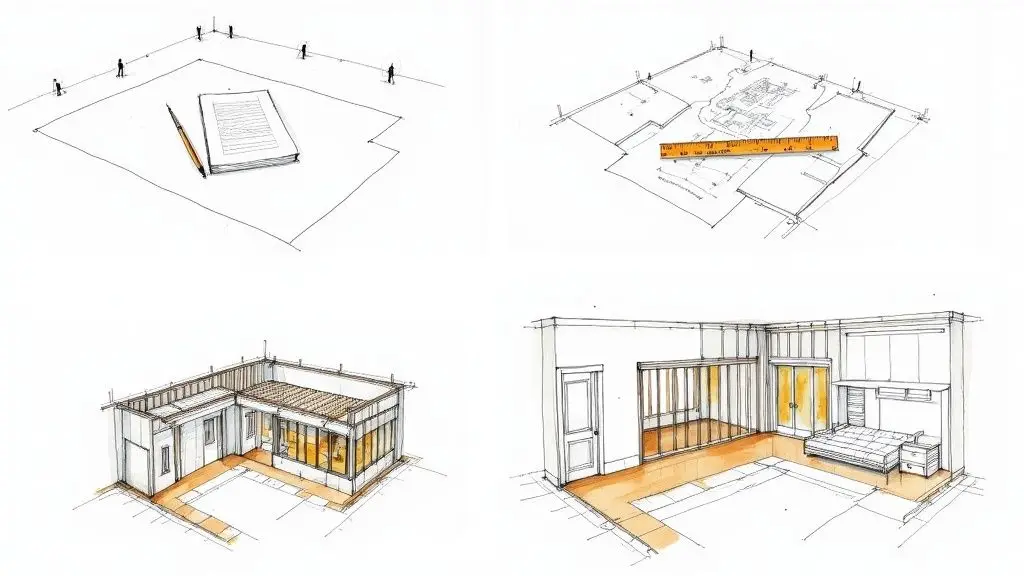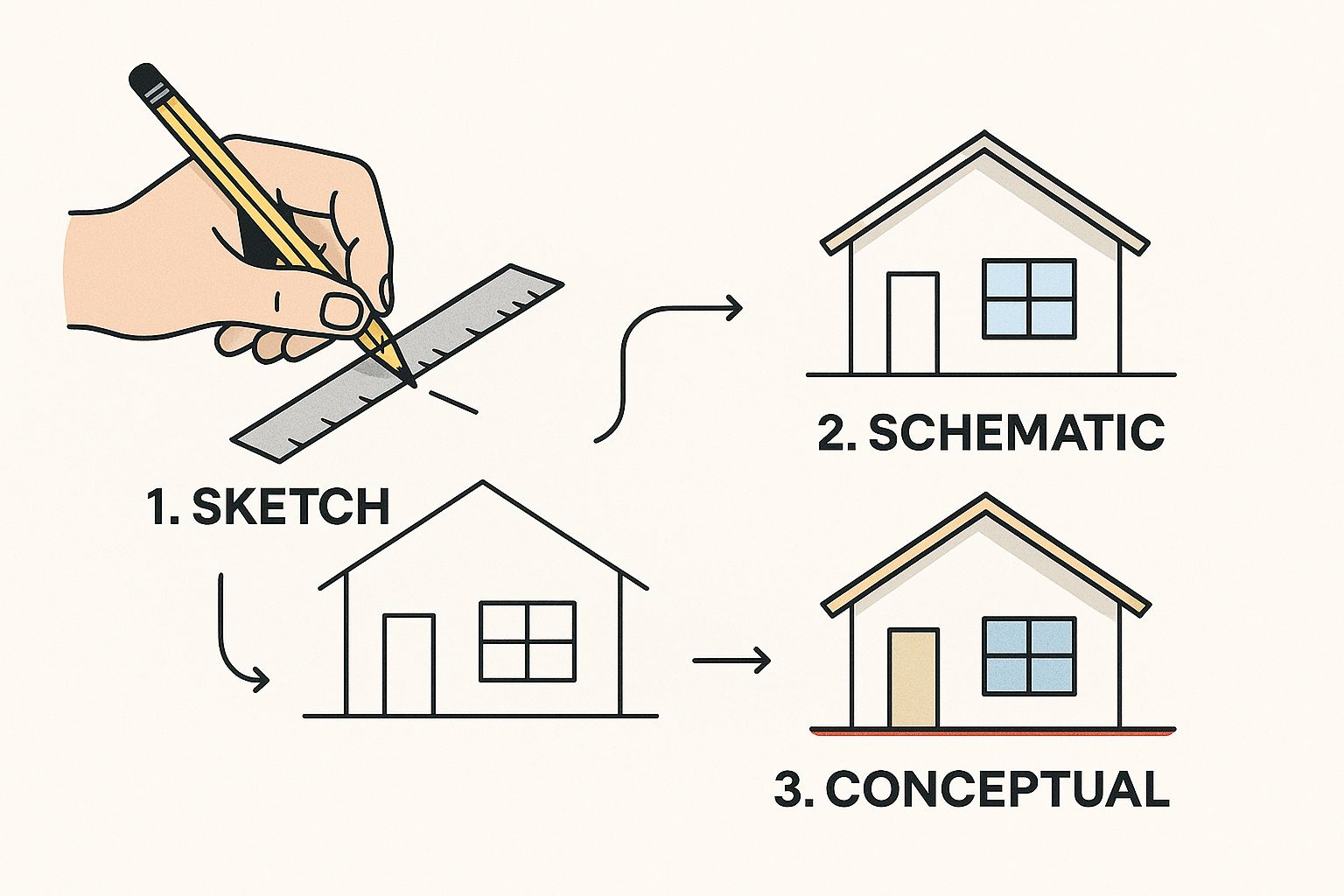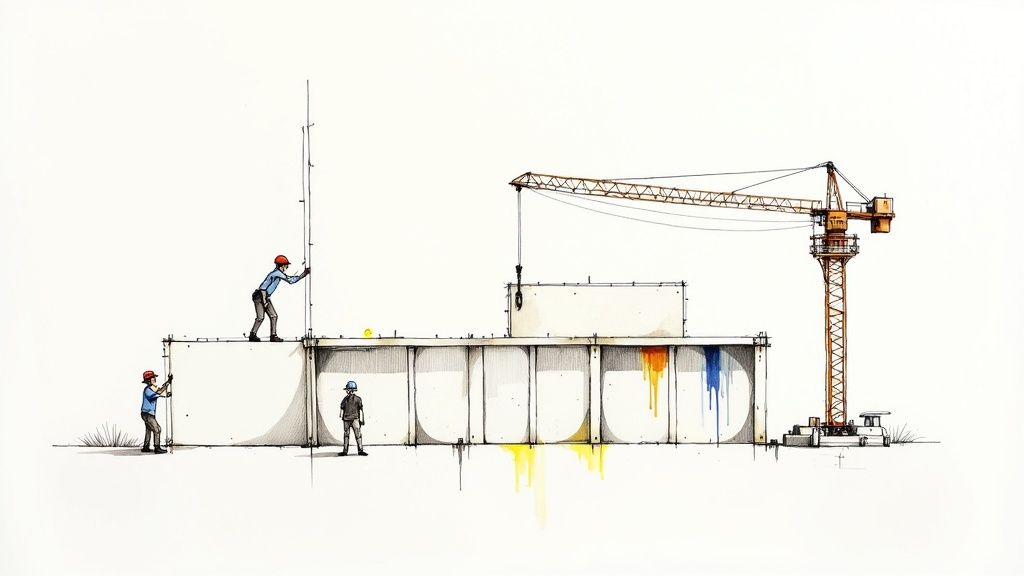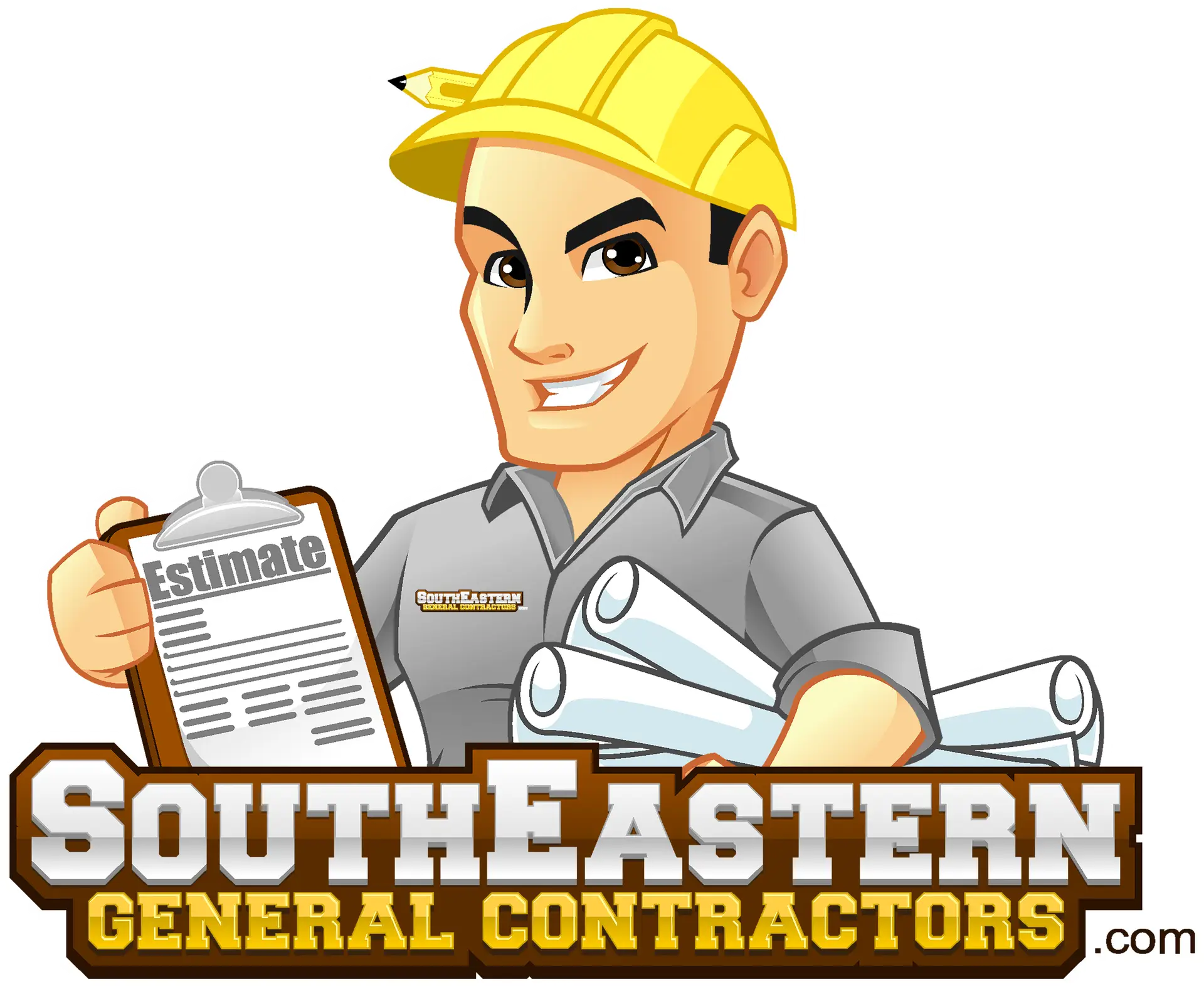
Your Custom Home Building Process Guide
Building a custom home is about so much more than just sticks and bricks; it’s about creating a personal legacy. The custom home building process isn't a checklist you simply work through. It's a creative, collaborative journey that brings your unique vision to life, built on a foundation of trust and clear communication from day one.

Your Custom Home Building Journey Starts Here
Let's be honest: the idea of building a custom home can feel overwhelming. It's a huge undertaking and likely one of the most significant financial investments you'll ever make. This is why the very first decision you make—choosing the right partner to guide you—is also the most critical one. A great outcome isn't just about the beautiful house at the end; it's about the experience, the trust, and the confidence you feel throughout the entire process.
At South Eastern General Contractors (SEGC), we've spent over 21 years building our reputation on that very idea. Our entire approach is grounded in creating lasting relationships, a commitment that has made us a trusted local leader in the Fayetteville and Lumberton communities.
Why Your Builder Is Your Most Important Decision
The right builder wears many hats. They're far more than just a project manager who schedules subcontractors; they are your advocate, your trusted advisor, and your on-the-ground problem-solver. But here’s the thing: without a clear vision from you, even the world's best builder can only construct a house, not a home that truly fits your life. That’s why our process always begins by listening.
A true builder-client partnership involves:
- Translating Vision into Reality: We start by understanding your needs—from your family's daily routines to your long-term goals—and help translate those ideas into a functional, beautiful design.
- Ensuring Financial Transparency: You should never be in the dark about costs. We provide clear, detailed financial oversight, so you can make informed decisions that align with your budget and avoid stressful surprises down the road.
- Navigating Local Complexities: Our deep roots in this region mean we have an intimate understanding of the specific zoning laws, permitting requirements, and environmental factors unique to North Carolina.
"Your builder isn’t a mind reader, and they’re not designing your dream home—you are. Without a crystal-clear understanding of how you want to live in your space, you’ll end up making rushed decisions under pressure."
Our promise of a true partnership is backed by our unique credentials. As a Native American-owned, 8(a), and HUBZone certified firm, SEGC operates with a proven level of integrity and financial stability. These certifications aren't just labels; they reflect our deep commitment to ethical practices and community investment, giving you peace of mind that you're working with a team dedicated to building legacies, not just structures.
This guide will walk you through each phase of the journey, showing you exactly how to build with confidence.
Setting a Foundation of Vision and Feasibility
Building a custom home doesn't start with digging a foundation. It begins much earlier, with an idea—a clear vision of how you and your family want to live. This initial phase is all about translating those daydreams into a realistic, achievable plan.
From our 21+ years of proven results, we can tell you that rushing this step is one of the biggest and most expensive mistakes you can make. Without a clear vision, a builder can give you a house, but it won’t feel like your home.
This is where the real work begins. We help you think past the basics like square footage and the number of bedrooms. How will your daily life flow through these spaces? Do you need a dedicated, quiet home office? Or is your home the central hub for every family holiday and get-together? These lifestyle details are the true cornerstones of a great design.
Defining Your Vision and Budget
Your vision is the North Star for the entire project. Every single decision, from the overall layout down to the cabinet pulls, should align with it. When people make rushed choices halfway through construction, it almost always leads to costly change orders and, even worse, a home they don't completely love.
To get ahead of this, we always encourage clients to sort their ideas into a few key buckets:
- Your Lifestyle Needs: Think about your family's daily rhythm, your hobbies, and what you see for your future. Do you want a main-floor primary suite to make aging in place easier? A hardworking mudroom to contain the chaos of kids and sports gear?
- Aesthetic Preferences: Start gathering inspiration, but try to pinpoint the feeling you want your home to have. Are you aiming for bright, open, and airy? Or something more cozy, private, and traditional?
- Must-Haves vs. Nice-to-Haves: This is crucial. Creating this list early on is your best tool for managing the budget. It lets you spend money intentionally on the things that matter most to you.
This initial creative process is where your abstract ideas start taking tangible shape, just as an architect begins sketching out the first schematic designs.

This image perfectly captures that critical moment when vision meets paper, setting the entire project in motion.
Of course, a realistic budget is just as critical as your vision. A proper budget needs to cover everything: the land itself, architectural and design fees, all construction costs, landscaping, and a healthy contingency fund. We always recommend setting aside 10-15% for those inevitable surprises. A comprehensive budget is your best defense against the financial stress that can derail a project.
Before you get too far down the road, it's a good idea to run through some initial checks to make sure you're starting on solid ground. This checklist helps organize those crucial first steps.
Initial Feasibility Checklist
| Checklist Item | Actionable Insight | Why It Matters |
|---|---|---|
| Articulate Your Vision | Create a list of must-haves, wants, and non-negotiables. Think about daily routines. | Provides a clear "North Star" for all design and budget decisions, preventing costly changes later. |
| Establish a Total Budget | Get pre-qualified for a loan. Account for land, design, construction, and a 10-15% contingency. | Financial clarity is non-negotiable. It proves you're a serious buyer and prevents project-derailing stress. |
| Evaluate Potential Land | Look beyond the view. Investigate zoning, utilities, soil quality, and drainage before buying. | The land you choose can hide expensive problems. Early due diligence saves thousands in unexpected site work costs. |
| Interview & Select a Builder | Talk to a few reputable builders early. Check their experience, references, and communication style. | A good builder becomes your partner, guiding you through feasibility and offering invaluable insights from day one. |
This simple exercise ensures you’re not just dreaming, but planning with purpose. It lays the groundwork for a smoother, more predictable building journey.
From Site Selection to Financial Pre-Qualification
The piece of land you choose will be your home’s permanent partner, so this decision deserves careful thought. Having built homes all over the Fayetteville and Lumberton communities, we’ve seen firsthand how site conditions can make or break a project. A gorgeous, tree-lined lot can easily hide some very expensive problems just below the surface.
At SEGC, proactive feasibility is at the core of what we do. As a Native American-owned and HUBZone certified firm, our commitment to thorough planning is part of our DNA. We help clients evaluate a potential site’s soil quality, drainage, and zoning hurdles before they sign on the dotted line.
For example, we once worked with a client in Lumberton who was ready to buy a beautiful wooded lot. Our initial assessment, however, showed poor soil that would have required a complex and costly engineered foundation. By catching this early, we helped them find a more suitable property just down the road, saving them tens of thousands of dollars and a massive future headache. You can learn more about navigating these choices by reading about the 7 most common mistakes people make when building a custom home.
Finally, getting pre-qualified for your construction loan is an absolute must. It’s not just about knowing your budget; it’s about showing land sellers and builders that you’re a serious, prepared buyer. This financial clarity ensures the entire custom home building process starts on a firm footing, giving you the confidence to move forward.
Turning Blueprints Into Building Permits
Once you have a solid vision and a realistic budget, it's time to get down to the exciting part: turning your ideas into actual architectural plans. This is where we move from dreams to drawings, translating your family’s lifestyle and personal taste into a detailed set of blueprints. It's a hugely important stage, and my job is to guide you through it to make sure the final design isn't just beautiful, but also practical to build and fully compliant with every local code.
I see this design phase as a genuine partnership. My team and I at SEGC are here to connect what you're imagining with the real-world nuts and bolts of construction. We sit down with you and the architect, bringing our 21+ years of proven results and boots-on-the-ground experience to every conversation. This collaboration ensures every single line on that blueprint has a purpose and, just as importantly, fits within your budget.
The Collaborative Design Process
Crafting the perfect blueprints is a back-and-forth process. It's all about refinement. We'll start with some initial sketches and basic floor plans, and from there, we'll tweak and adjust them based entirely on your feedback. We’ll talk through everything—from the natural flow between rooms to where the windows should go to catch the morning sun, all the way to the specific structural engineering needed to make it all happen.
Our input as your builder during this stage is priceless. I can’t tell you how many times we’ve spotted a potential construction headache or a smart way to save money long before it could become a costly issue on the job site.
For instance, we might see that shifting a wall just six inches could dramatically simplify the HVAC ductwork. That’s a small change on paper that could save you thousands on mechanical systems without changing the look or feel of the room one bit. It's this kind of proactive thinking that builds the trust our clients have in us.
Material Selections and Their Impact
Now for the fun stuff—picking the materials and finishes that will give your home its unique personality. While it's exciting, these decisions carry a lot of weight, affecting both your budget and the overall construction timeline. That's why we lock in these choices as early as possible.
We'll walk you through all the key selections, helping you weigh the pros and cons.
- Exterior Finishes: We'll look at siding, brick, stone, and roofing options that not only fit your aesthetic but are tough enough to handle North Carolina's weather.
- Windows and Doors: These choices are huge, impacting everything from curb appeal to your home's long-term energy efficiency.
- Key Interior Features: This is the heart of your home's interior—the flooring, cabinets, and countertops you'll interact with every single day.
By finalizing these big-ticket items before the first shovel hits the dirt, we can get ahead of long lead times for certain materials. This kind of detailed, upfront planning is what keeps a complex project running smoothly and prevents frustrating delays.
Demystifying Permits and Approvals
For most homeowners, navigating the maze of building permits and city approvals is easily the most overwhelming part of the custom home building process. In our area, getting the right permits from local authorities in Fayetteville or Lumberton requires an intimate knowledge of zoning laws, building codes, and environmental rules. Frankly, it can be a real headache if you don't do it every day.
This is an area where our local leadership and the relationships we've built over decades really make a difference. SEGC takes care of the entire permitting process for you. We handle all the paperwork, submit the plans, coordinate with city and county inspectors, and field any questions that pop up. Our meticulous approach helps cut through the red tape, getting us to the groundbreaking that much faster.
A Fayetteville Story: Proactive Problem-Solving
We recently had a client whose dream property came with a tricky zoning issue involving setback requirements. The city's initial read on the rules would have seriously shrunk their backyard, a key part of their vision. Instead of just accepting it, we dug into our knowledge of local ordinances and used our established relationships at the planning office. We presented a carefully documented case with an alternative site plan that still honored the code's intent while giving our client the space they wanted. The city approved our plan, and our client got the home they envisioned without a lengthy and expensive variance hearing.
This is the kind of advocacy and hands-on expertise we bring to every single project. As an 8(a) and HUBZone certified firm, we’re held to an incredibly high standard of thoroughness and integrity. We don’t just build homes; we clear the path so you can build your legacy.
Managing Construction and Your Build Site
This is where the real excitement begins. All the blueprints, plans, and groundwork finally start to become the physical structure of your new home. The active construction phase is an amazing time where you see tangible progress every single day. It’s also where a builder’s real-world expertise in project management, quality control, and communication is put to the test.
We manage every build site with a system we've refined over 21+ years of proven results. Our entire approach is built on two things: relentless on-site oversight and completely transparent communication. We do this to ensure that what we build is a perfect match for the vision we created together. This isn't just about checking boxes on a schedule; it's about orchestrating a complex dance of skilled trades, materials, and inspections to create a seamless workflow from start to finish.
From Foundation to Framing: The Core Milestones
Once the land is cleared and graded, the first major step is pouring the foundation. This is the literal bedrock of your home, and we treat it with the absolute seriousness it deserves. From there, the structure really starts to take shape, moving through a series of critical stages that bring your home’s form to life.
You’ll see your home evolve through these key phases:
- Foundation and Slab: We make sure the concrete work is done flawlessly. This creates the stable, level base that the entire structure will rest on for decades to come.
- Framing: This is when the skeleton of your home goes up, defining the rooms, walls, and roofline. It's often the first time you can actually walk through the spaces you’ve only seen on paper—a truly memorable moment.
- Mechanical Rough-ins: Before any drywall goes up, our licensed experts get to work installing the home's critical systems—the plumbing, electrical wiring, and HVAC ductwork that run behind the walls and ceilings.
- Roofing and "Drying In": The roof, windows, and exterior sheathing are installed to protect the interior from the elements. This crucial milestone is known as "drying in" and allows interior work to begin safely.
Each of these stages requires meticulous coordination and is immediately followed by mandatory municipal inspections. Our deep experience in Fayetteville and Lumberton means we have excellent working relationships with local inspectors, which helps keep the project moving forward smoothly without ever cutting a single corner on quality.
Our Approach to Site Management and Quality Control
A well-managed job site is a safe, efficient, and productive one. As your general contractor, we are the central hub for every single thing that happens on your property. We are responsible for every person, every delivery, and every action that takes place, and it’s a responsibility we take very seriously.
A Testimonial to Trust: "Watching our home go up was incredible, but what really gave us peace of mind was the SEGC team. Our project manager was on-site constantly, and we got regular updates with photos and explanations. We never had to wonder what was happening or chase someone down for an answer. That level of trust is priceless." – Recent Fayetteville Client
Our management style is all about being proactive, not reactive. We prevent problems before they start. Here’s how:
- Rigorous Subcontractor Vetting: We don’t work with just anyone. We have a select group of trusted, licensed, and insured trade partners who consistently meet our high standards for craftsmanship and professionalism. We share some of our own criteria in our guide on how to find a good contractor.
- Regular Site Meetings: We schedule consistent on-site meetings with you, the architect, and key tradespeople. This keeps everyone aligned and gives you the perfect chance to ask questions and see the progress for yourself.
- Unwavering Quality Control: Our project managers are on-site daily. They aren’t just checking for code compliance; they are inspecting the work to ensure it meets our own stringent SEGC quality benchmarks. This hands-on oversight is a non-negotiable part of our promise to you.
As a HUBZone certified firm, our commitment goes beyond just the build site. We make it a priority to hire skilled local talent and partner with area suppliers whenever we can, reinvesting in the very communities we help build. This approach strengthens our projects and our neighborhoods. The custom home model, built on individual contracts, provides a unique stability compared to speculative building. Its resilience often stems from its connection to household wealth rather than fluctuating interest rates, making it a steadier part of the construction industry. You can learn more about these custom home building economic trends and their market impact.
Ultimately, managing the construction phase is about honoring the trust you've placed in us. We are your eyes and ears on the ground, ensuring every nail, pipe, and wire contributes to building a legacy, not just a house.
Perfecting Finishes and Your Final Walkthrough
As the roar of heavy machinery fades, the atmosphere on the job site changes. This is when the house begins to feel like your home. We shift our focus from the broad strokes of framing and roofing to the fine details—the surfaces you’ll touch and the fixtures you’ll use every single day. This is the finishing stage, and it’s where true craftsmanship really comes into its own.

Here at SEGC, our promise of trust and quality becomes most visible during these final weeks. With over 21 years of proven results, we know that perfection is found in the smallest details. From the flawless sheen of the drywall finish to the precise alignment of your kitchen cabinets, our team’s obsession with getting it right ensures every element meets our exacting standards—and, more importantly, yours.
Bringing Your Interior Vision to Life
Once the home is "dried in"—meaning the roof, windows, and doors are installed and it's protected from the elements—the interior work kicks into high gear. This isn't a random flurry of activity; it's a carefully orchestrated sequence. Each trade’s work lays the foundation for the next, making precision and patience absolutely essential for a stunning final result.
The finishing phase generally follows a specific order:
- Drywall Installation and Finishing: First, sheets of drywall are hung, then taped and mudded to create perfectly smooth walls and ceilings. This is an art form—any imperfection here will stick out like a sore thumb once the paint goes on.
- Prime and First Coat of Paint: A primer coat seals the new drywall, creating an ideal surface for the first coat of your chosen paint colors to adhere to.
- Flooring and Cabinetry Installation: With the initial painting done, we can lay down hard-surface flooring like hardwood or tile. At the same time, your custom cabinets are carefully installed in the kitchen, bathrooms, and any other spaces with built-ins.
- Doors, Trim, and Millwork: Next, interior doors are hung. This is also when all the baseboards, window casings, and crown molding are installed, which demands a master carpenter’s keen eye for detail.
- Final Touches: Finally, countertops are set, plumbing and light fixtures are connected, and the final coat of paint is meticulously applied to walls and trim.
Our Lumberton Legacy Story
We recently worked with a client in Lumberton who had their heart set on a specific type of reclaimed heart pine flooring that was nearly impossible to find. Instead of suggesting they settle for something else, we tapped into our deep network of regional suppliers. Our project manager personally drove three hours to a specialty mill just to inspect the wood and ensure it was the perfect match for their vision. It’s that level of dedication that shows we’re not just building structures; we’re building legacies.
The Final Walkthrough and Your Punch List
Before we hand you the keys, we schedule one of the most important meetings of the entire project: the final walkthrough. This is your chance to tour the finished home with your project manager and point out any items that need a final tweak. This list of small adjustments—a paint touch-up here, a sticky door there—is known in the industry as the punch list.
Don't be alarmed by a punch list; it's a normal and healthy part of any high-quality build. It shows a builder’s commitment to getting every last detail perfect. As an 8(a) and HUBZone certified firm, our process is built on a foundation of accountability. The punch list is the final, tangible proof of that promise. We simply don't consider a project complete until you are 100% satisfied.
This intense focus on the finishing touches is what truly sets a custom home apart from a production build. Custom home building represents a vital slice of the housing market, a segment where client satisfaction is the only metric that matters. To see how these unique projects contribute to the market, you can explore the latest housing start statistics. Ultimately, this dedication is what makes the custom home building process with a partner like SEGC so incredibly rewarding.
Your Custom Home Building Questions Answered
Building a custom home is a huge undertaking, and it's natural to have a lot of questions. With over 21+ years of experience building legacies for families in Fayetteville, Lumberton, and the surrounding areas, we've heard them all. We wanted to pull back the curtain and share honest, straightforward answers to the questions we get asked most often.
How Long Does the Custom Home Building Process Typically Take?
This is usually the first thing people want to know, and the honest answer is: it depends. The complexity of your design is the biggest factor. That said, a good rule of thumb is to plan for the entire journey—from our initial design chat to the day you get the keys—to take somewhere between 12 and 18 months.
We can break that timeline down a bit:
- Design & Approvals (3-6 months): This is where we dream big. It involves creating the architectural plans, picking out materials, and getting all the necessary permits from local officials. This part of the timeline is driven by how quickly decisions are made and how backed up the permitting office is.
- Construction (9-12 months): Here’s where the dirt starts moving. From pouring the foundation to walking through the final punch list, this is the active building phase. Things like unpredictable weather, lead times for special-order materials, or the sheer intricacy of the design can influence this schedule.
Our philosophy at SEGC is built on radical transparency. You'll get a detailed project schedule from day one, and we keep the lines of communication wide open. You'll always know exactly where your project stands.
What Is the Difference Between a Custom and a Production Builder?
Understanding this difference is crucial because it sets the entire tone for your project. The real distinction comes down to the level of personalization you get and the kind of relationship you have with your builder.
A production builder typically buys large tracts of land and builds houses from a set menu of pre-designed floor plans. They have a streamlined process designed for volume and efficiency, which is great for some, but it often means you have very little room to make changes.
A custom builder like us works differently. We partner with you to design and build a completely unique home on your own land. It’s a process driven entirely by your vision. You have total freedom over the layout, materials, and finishes. It’s less of a transaction and more of a collaborative partnership focused on creating a home that is a true reflection of you and your family.
The right builder is more than just a contractor; they become your guide and your biggest advocate. The whole relationship has to be built on trust and clear communication. Checking out our guide on the most important questions to ask a general contractor can help you build that foundation of trust from your very first meeting.
How Can I Control Costs During the Building Process?
Keeping the budget in check is, without a doubt, one of the biggest concerns for anyone building a home. The good news is that with smart planning and a builder who believes in transparency, you can absolutely maintain control over your finances.
The key is to do the hard work upfront. The single most effective strategy for managing costs is to finalize your design and all your major material selections before we ever break ground. Doing this nearly eliminates the need for change orders—those mid-construction alterations that can throw both the budget and the timeline for a loop.
Another non-negotiable is having a contingency fund. We always advise clients to set aside 10-15% of the total project cost for the unexpected. This isn't for poor planning; it's for real-life scenarios. It's smart, realistic preparation that buys you incredible peace of mind.
Our open-book process at SEGC means you see where every dollar is going. We’ll walk you through detailed cost breakdowns and talk about value engineering, making sure your money is spent wisely.
What Do Certifications Like 8(a) and HUBZone Mean for Me?
You might see these federal certifications and think they only matter for government work, but they are actually a powerful signal of a company's character and reliability—things that matter a great deal to a homeowner.
Getting SBA 8(a) and HUBZone certified is an incredibly tough process. The government puts a company's financial stability, business practices, and operational integrity under a microscope.
For you, this translates to tangible benefits:
- Proven Stability: You're working with a firm that has passed rigorous financial health checks, proving we're built to last.
- Unquestionable Integrity: These certifications are a third-party endorsement of our commitment to ethical, accountable business practices.
- Community Investment: As a Native American-owned and HUBZone-certified company, we are deeply committed to investing back into our local communities, especially in Fayetteville and Lumberton. It's not just business; it's personal.
Ultimately, these credentials aren't just letters on a page. They are independent proof that you’re partnering with a builder who is stable, ethical, and dedicated to building a lasting legacy right alongside you.
At South Eastern General Contractors, our mission is to build more than just structures; we build lasting relationships and legacies. If you’re ready to start a conversation about your custom home, we invite you to connect with our team.



